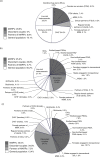Can the UNAIDS modes of transmission model be improved? A comparison of the original and revised model projections using data from a setting in west Africa
- PMID: 23921619
- PMCID: PMC3815012
- DOI: 10.1097/01.aids.0000432476.22616.2f
Can the UNAIDS modes of transmission model be improved? A comparison of the original and revised model projections using data from a setting in west Africa
Abstract
Objective: The UNAIDS modes of transmission model (MoT) is a user-friendly model, developed to predict the distribution of new HIV infections among different subgroups. The model has been used in 29 countries to guide interventions. However, there is the risk that the simplifications inherent in the MoT produce misleading findings. Using input data from Nigeria, we compare projections from the MoT with those from a revised model that incorporates additional heterogeneity.
Methods: We revised the MoT to explicitly incorporate brothel and street-based sex-work, transactional sex, and HIV-discordant couples. Both models were parameterized using behavioural and epidemiological data from Cross River State, Nigeria. Model projections were compared, and the robustness of the revised model projections to different model assumptions, was investigated.
Results: The original MoT predicts 21% of new infections occur in most-at-risk-populations (MARPs), compared with 45% (40-75%, 95% Crl) once additional heterogeneity and updated parameterization is incorporated. Discordant couples, a subgroup previously not explicitly modelled, are predicted to contribute a third of new HIV infections. In addition, the new findings suggest that women engaging in transactional sex may be an important but previously less recognized risk group, with 16% of infections occurring in this subgroup.
Conclusion: The MoT is an accessible model that can inform intervention priorities. However, the current model may be potentially misleading, with our comparisons in Nigeria suggesting that the model lacks resolution, making it challenging for the user to correctly interpret the nature of the epidemic. Our findings highlight the need for a formal review of the MoT.
Figures



References
-
- Anderson RM, Garnett GP. Mathematical models of the transmission and control of sexually transmitted diseases. Sex Transm Dis 2000; 27:636–643 - PubMed
-
- Anderson RM, Gupta S, Ng W. The significance of sexual partner contact networks for the transmission dynamics of HIV. J Acquir Immune Defic Syndr 1990; 3:417–429 - PubMed
-
- Regan DG, Wilson DP. Modelling sexually transmitted infections: less is usually more for informing public health policy. Trans R Soc Trop Med Hyg 2008; 102:207–208 - PubMed
-
- UNAIDS and The World Bank New HIV infections by mode of transmission in West Africa: A multicountry analysis. 2010
Publication types
MeSH terms
LinkOut - more resources
Full Text Sources
Other Literature Sources
Medical

